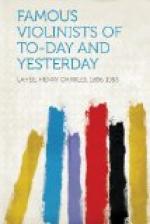This completes the list of English violinists of note who were born previous to the nineteenth century. The later ones we shall find in their place in succeeding chapters, but there have been very few violinists of English birth who have followed the career of the “virtuoso.” Even Antonio James Oury, who made a series of concert tours lasting nine years, during which he occasionally appeared in conjunction with De Beriot and Malibran, is hardly known as a “virtuoso,” and was not all English. But there are pathetic circumstances in regard to the career of Oury. He was the son of an Italian of noble descent, who had served as an officer in the army of Napoleon, and had been taken prisoner by the English. Making the best of his misfortunes the elder Oury settled in England, married a Miss Hughes, and became a professor of dancing and music.
The son, Antonio, began to learn the violin at the age of three, in which he was a year or two ahead of the average virtuoso, and he made great progress. By and by he heard Spohr, and after that his diligence increased, for he practised, during seven months, not less than fourteen hours a day. Even Paganini used to sink exhausted after ten hours’ practice. In 1820, we are told, he went to Paris and studied under Baillot, Kreutzer, and Lafont, receiving from each two lessons a week for several successive winters. With such an imposing array of talent at his service much might be expected of Mr. Oury, and he actually made his debut at the Philharmonic concerts in London.
There was another unfortunate officer of Napoleon who became tutor to the Princesses of Bavaria. His name was Belleville. Mr. Oury met his daughter, and, there being naturally a bond of sympathy between them, they married. She was an amiable and accomplished pianist, and together they made the nine years’ concert tour.
During the period in which the art of violin playing was being perfected on the Continent, the English were too fully occupied with commercial pursuits to foster and develop the art. Up to the present day the most eminent virtuoso is commonly spoken of as a “fiddler.” Even Joachim, when he went to a barber’s shop in High Street, Kensington, and declined to accept the advice of the tonsorial artist, and have his hair cropped short, was warned that “he’d look like one o’ them there fiddler chaps.” The barber apparently had no greater estimation of the violinist’s art than the latter had of the tonsorial profession, and the situation was sufficiently ludicrous to form the subject of a picture in Punch, and thus the matter assumed a serious aspect.
England has not been the home of any particular school of violin playing, but has received her stimulus from Continental schools, to which her sons have gone to study, and from which many eminent violinists have been imported.
The word “school,” so frequently used in connection with the art of violin playing, seems to lead to confusion. The Italian school, established by Corelli, appears to have been the only original school. Its pupils scattered to various parts of Europe, and there established other schools. To illustrate this statement, we will follow in a direct line from Corelli, according to the table given in Grove’s Dictionary.




